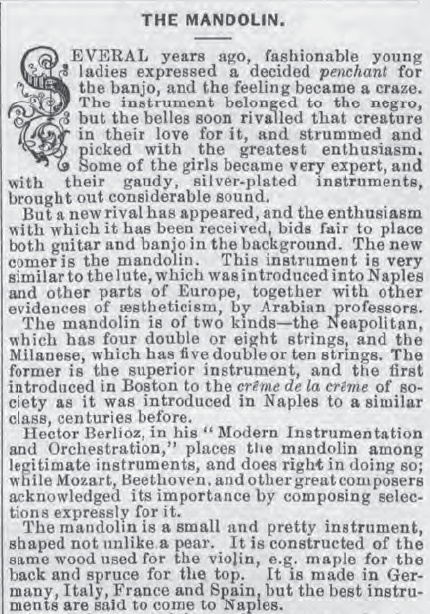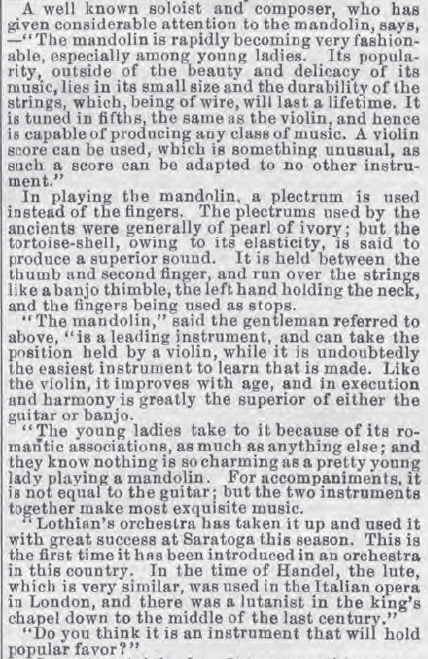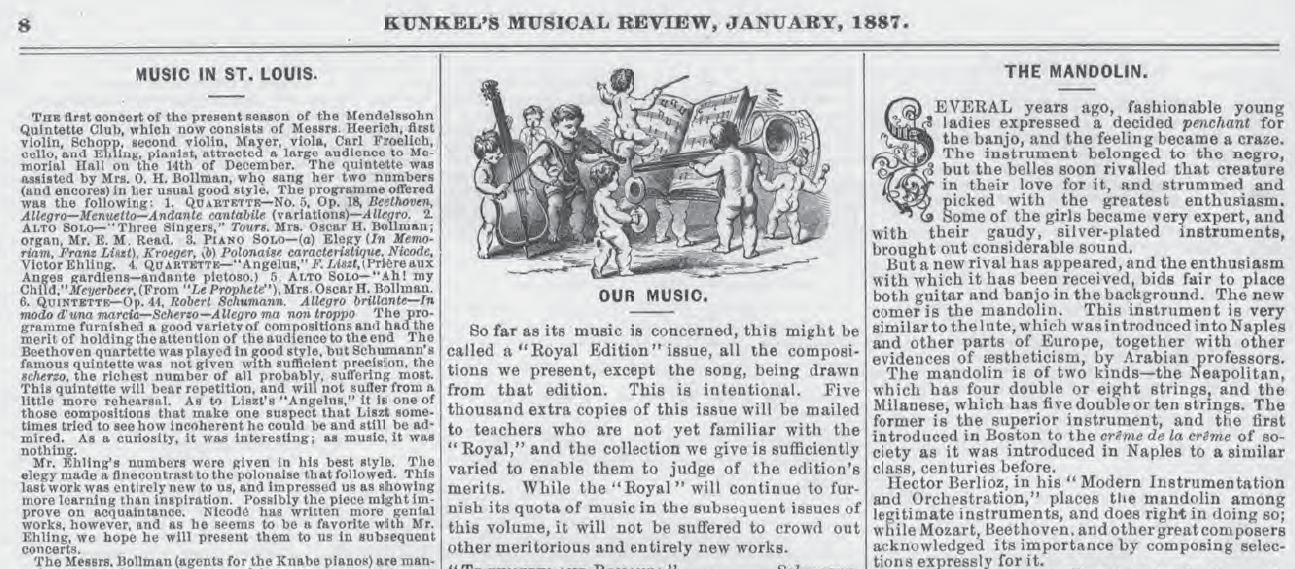| Kunkel's Musical Review |
|
Die Zeitschrift Kunkel's Musical Review ist online verfügbar: |
| Bitte
teilen sie diese Seite: |
  THE MANDOLIN.SEVERAL years ago, fashionable young ladies expressed a decided penchant for the banjo, and the feeling became a craze. The instrument belonged to the negro, but the belles soon rivalled that creature in their love for it, and strummed and picked with the greatest enthusiasm. Some of the girls became very expert, and with their gaudy, silver-plated instruments, brought out considerable sound. But a new rival has appeared, and the enthusiasm with which it has been received, bids fair to place both guitar and banjo in the background. The new comer is the mandolin. This instrument is very similar to the lute, which was introduced into Naples and other parts of Europe, together with other evidences of restheticism, by Arabian professors. The mandolin is of two kinds-the Neapolitan, which has four double or eight strings, and the Milanese, which has five double or ten strings. The former is the superior instrument, and the first introduced in Boston to the creme de la creme of society as it was introduced in Naples to a similar class, centuries before. Hector Berlioz, in his "Modern Instrumentation and Orchestration," places the mandolin among legitimate instruments, and does right in doing so; while Mozart, Beethoven. and other great composers acknowledged its importance by composing selections expressly for it. The mandolin is a small and pretty instrument, shaped not unlike a pear. It is constructed of the same wood used for the violin, e.g. maple for the back and spruce for the top. It is made in Germany, Italy, France and Spain but the best instruments are said to come to Naples. A well known soloist and composer, who has given considerable attention to the mandolin, says, -"The mandolin is rapidly becoming very fashionable, especially among young ladies. Its popularity, outside of the beauty and delicacy of its music, lies in its small size and the durability of the strings, which, being of wire, will last a lifetime. It is tuned in fifths, the same as the violin, and hence is capable of producing any class of music. A violin score can be used, which is something unusual, as such a score can be adapted to no other instrument." In playing the mandolin, a plectrum is used instead of the fingers. The plectrums used by the ancients were generally of pearl of ivory; but the tortoise-shell, owing to its elasticity, is said to produce a superior sound. It is held between the thumb and second finger and run over the strings like a banjo thimble, the ieft hand holding the neck, and the fingers being used as stops. "The mandolin," said the gentleman referred to above," is a leading instrument, and can take the position held by a violin, while it is undoubtedly the easiest instrument to learn that is made. Like the violin, it improves with age, and in execution and harmony is greatly the superior of either the guitar or banjo. "The young ladies take to it because of its romantic associations, as much as anything else; and they know nothing is so charming as a pretty young lady playing a mandolin. For accompaniments, it is not equal to the guitar; but the two instruments together make most exquisite music. "Lothian's orchestra has taken it up and used it with great success at Saratoga this season. This is the first time it has been introduced in an orchestra in this country. In the time of Handel, the lute, which is very similar, was used in the Italian opera in London, and there was a lutanist in the king's chapel down to the middle of the last century." "Do you think it is an instrument that will hold popular favor?" . " I most certainly do. It has everything to recommend it, and is refined, cultivated, and easily learned, besides producing music that is very beautiful. The cost is small, being from ten dollars to fifty dollars, though I have seen very fine instruments inlaid and gorgeously finished, that were valued at two hundred dollars."-Boston Traveller. See the complete scan: http://omeka.wustl.edu/omeka/items/show/1499 |
 |
| Wenn
sie diese Seite
ohne Navigationsleiste angezeigt bekommen, dann klicken sie hier um die MandoIsland Homepage zu öffen: |
 |